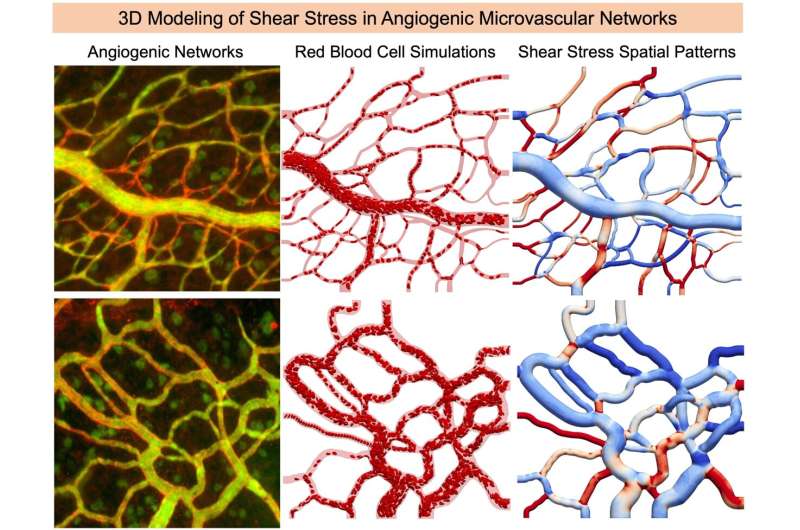This article has been reviewed according to Science X's editorial process and policies. Editors have highlighted the following attributes while ensuring the content's credibility:
fact-checked
trusted source
proofread
3D stress patterns in capillaries found to be caused by red blood cell squeezing

New and unique shear stress patterns can occur in angiogenic capillary (new blood vessel growth) networks, according to a new study titled "Angiogenic microvascular wall shear stress patterns revealed through three-dimensional red blood cell resolved modeling" published in the journal Function. There was also enhancement of low shear stress regions by red blood cells. Shear stress is the frictional force of the blood on the vessel wall.
Researchers from the New Jersey Institute of Technology and the University of Florida found this is due to red blood cells getting squeezed and deformed in these hair-sized blood vessels.
The growth and adaptation of new blood vessels in the body is key to many physiological processes in health and disease. This is true from embryonic development and natural changes during the aging process to diabetes, heart disease and tumor growth in cancer.
High-resolution computer simulations allowed researchers to demonstrate multiple types of 3D shear stress spatial variations which derive from distinct blood vessel surface shapes and structures. The research team was able to identify the existence of shear stress hot and cold spots caused by red blood cells interacting with these unique surface shapes. The researchers identified shear stress spatial patterns, which vary over time and help explain how fluctuations follow timescales of red blood cell "footprints."
"Altogether, this study provides a conceptual framework for understanding how shear stress might regulate the formation of new blood vessels in a living organism," said Peter Balogh, corresponding author of the study.
These findings inspire new research directions with a high potential to improve human health, including helping to predict tumor growth patterns and guiding new treatments. This allows for early detection of problems during embryonic development or developing new ways to improve blood flow in heart disease.
More information: Mir Md Nasim Hossain et al, Angiogenic Microvascular Wall Shear Stress Patterns Revealed Through Three-Dimensional Red Blood Cell Resolved Modeling, Function (2023). DOI: 10.1093/function/zqad046





















